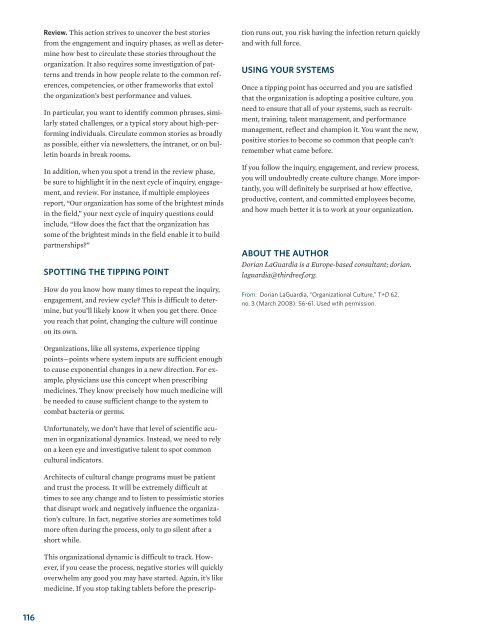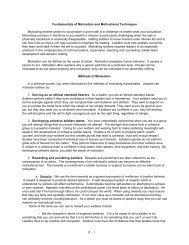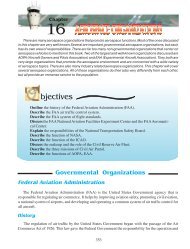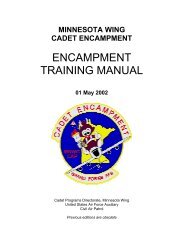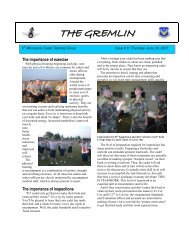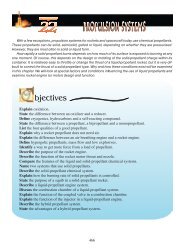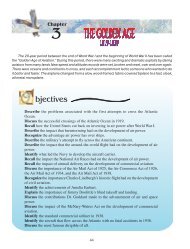Review. This action strives to uncover the best storiesfrom the engagement and inquiry phases, as well as determinehow best to circulate these stories throughout theorganization. It also requires some investigation of patternsand trends in how people relate to the common references,competencies, or other frameworks that extolthe organization’s best performance and values.In particular, you want to identify common phrases, similarlystated challenges, or a typical story about high-performingindividuals. Circulate common stories as broadlyas possible, either via newsletters, the intranet, or on bulletinboards in break rooms.In addition, when you spot a trend in the review phase,be sure to highlight it in the next cycle of inquiry, engagement,and review. For instance, if multiple employeesreport, “Our organization has some of the brightest mindsin the field,” your next cycle of inquiry questions couldinclude, “How does the fact that the organization hassome of the brightest minds in the field enable it to buildpartnerships?”SPOTTING THE TIPPING POINTHow do you know how many times to repeat the inquiry,engagement, and review cycle? This is difficult to determine,but you’ll likely know it when you get there. Onceyou reach that point, changing the culture will continueon its own.This organizational dynamic is difficult to track. However,if you cease the process, negative stories will quicklyoverwhelm any good you may have started. Again, it’s likemedicine. If you stop taking tablets before the prescriptionruns out, you risk having the infection return quicklyand with full force.USING YOUR SYSTEMSOnce a tipping point has occurred and you are satisfiedthat the organization is adopting a positive culture, youneed to ensure that all of your systems, such as recruitment,training, talent management, and performancemanagement, reflect and champion it. You want the new,positive stories to become so common that people can’tremember what came before.If you follow the inquiry, engagement, and review process,you will undoubtedly create culture change. More importantly,you will definitely be surprised at how effective,productive, content, and committed employees become,and how much better it is to work at your organization.ABOUT THE AUTHORDorian LaGuardia is a Europe-based consultant; dorian.laguardia@thirdreef.org.From: Dorian LaGuardia, “Organizational Culture,” T+D 62,no. 3 (March 2008): 56-61. Used wtih permission.Organizations, like all systems, experience tippingpoints—points where system inputs are sufficient enoughto cause exponential changes in a new direction. For example,physicians use this concept when prescribingmedicines. They know precisely how much medicine willbe needed to cause sufficient change to the system tocombat bacteria or germs.Unfortunately, we don’t have that level of scientific acumenin organizational dynamics. Instead, we need to relyon a keen eye and investigative talent to spot commoncultural indicators.Architects of cultural change programs must be patientand trust the process. It will be extremely difficult attimes to see any change and to listen to pessimistic storiesthat disrupt work and negatively influence the organization’sculture. In fact, negative stories are sometimes toldmore often during the process, only to go silent after ashort while.116
15.2 Manage Change –Not the Chaos Caused by ChangeBy Beverly GoldbergOBJECTIVES:4. Define the three stages of the change communication framework.5. Identify the major roadblock to managing change successfully.6. List necessary steps for successfully managing change in an organization.In the 1400s, in the city of Mainz, Germany, JohannesGutenberg invented movable type and revolutionized theworld. Typesetting, letter by letter, was done by handfrom then until the 1880s, when mechanized typesetting– linotype – made it possible to se whole lines of type in asingle operation. In the 1950s, cold type became commonplace,allowing for even faster typesetting; then, inthe mid-to-late ‘80s, the development of affordable computersthat enabled almost instantaneous typesettingbegan a new publishing revolution that has not ended.Today, desktop publishing means quick, easy and lesscostly delivery of an incredible variety of publications.The times between these changes – 480 years, 70years and 20 years – are a good indicator of the increasedspeed with which change is taking place. As a result,change must be managed differently: The classic changemanagement techniques that helped organization institutionalizechange are no longer adequate to meet today’sneeds.According to classic theory, change management requiredseveral steps: unfreezing the organization’s existingculture so that a change could be brought in, creatingcognitive recognition to open the workforce to what wasnew, and then refreezing the culture once the change wasaccepted. The idea was that the culture would then remainconstant until the next change came along. Thatmay have worked when change came about only every 20years or so. In a world in which change seems to occurevery 20 minutes, a new framework for managing changeis necessary (see chart below).In this framework, the first or Static Stage, as in classicchange management theory, calls for unfreezing thecurrent culture by convincing employees that the organizationis changing and the changes have the strong supportof senior management. The second or Fluid Stagebegins when employees start to understand that thechanges will benefit them as well as the organization.They recognize the whys and wherefores of what is newand they accept it. Then, breaking with the classic idea ofrefreezing the culture as a final stage, the culture ismoved to a Dynamic Stage, where people work with thenew machines or processes and act in the new manner,but await – and even anticipate – the next changes thatwill be made. In other words, openness to change and anticipatingchange become the mind-set of the organization.A LABORIOUS TASKHelping employees through change is not an easytask. It requires formal programs that must be introducedgradually and managed with care and thought. They mustbe planned for with the same care as the new strategy ortechnology that is making change necessary. Each part ofa change program must be constructed so that the need tobe prepared for constant change reaches – and is understoodby – employees at all levels. But this is far easiersaid than done.The major roadblock to managing change successfullyis the fact that change does not happen in isolation. Takethe case of a major East Coast insurance firm that encounteredmore than a few pitfalls when it attempted tobring about change.The technology services group was trying to achievethe goal of employee acceptance of computer-aided softwareengineering (CASE), a leading-edge technology fordeveloping computer programs that requires a number ofchanges in the way people work and the way they thinkabout their work. CASE shifts the emphasis in developingprograms from writing the programs, which is the job ofprogrammers, to analyzing the business function the proStatic Fluid DynamicThe mind-set of theorganization isfrozen and needs:Senior-level determinationto takea new roadEmployee awarenessthat survivalmeans changeAs the mind-setopens, build recognition,understanding,and knowledgeby:DemonstrationsOpportunities forlearningTrainingThe mind-set isopen to what is newand other projects:AnticipatorycapabilitiesFlexibilityAcceptance ofcontinuous changeand learning117
- Page 1 and 2:
VOLUME FOUR STRATEGIC PERSPECTIVESL
- Page 3 and 4:
VOLUME FOUR STRATEGIC PERSPECTIVESL
- Page 5 and 6:
VOLUME FOUR STRATEGIC PERSPECTIVESL
- Page 7:
VOLUME FOUR STRATEGIC PERSPECTIVESL
- Page 10 and 11:
12CHAPTER 12INTRODUCTION TO STRATEG
- Page 12 and 13:
12.1 Strategic Leadership: Defining
- Page 14 and 15:
mandates or resolutions that would
- Page 16 and 17:
and ambiguity, aspiring strategic l
- Page 18 and 19:
12.2 National Security StrategyThe
- Page 20 and 21:
within our borders has always been
- Page 22 and 23:
front common challenges like violen
- Page 24 and 25:
and our strategy, not sector earmar
- Page 26 and 27:
thinking about organizations. She m
- Page 28 and 29:
A systemic approach to failure is m
- Page 30 and 31:
The late W. T. Grant Company is a r
- Page 32 and 33:
the resources - setting the directi
- Page 34 and 35:
focal point for describing and inte
- Page 36 and 37:
Consequently, we do not restrict th
- Page 38 and 39:
paragraphs, Web pages, then edit an
- Page 40 and 41:
Web, can be viewed as a CS attempt
- Page 42 and 43:
How to evaluate users and contribut
- Page 44 and 45:
13CHAPTER 13LEADING PUBLIC &VOLUNTE
- Page 46 and 47:
13.1 Leadership for Volunteers:The
- Page 48 and 49:
13.2 Take Root: Volunteer Managemen
- Page 50 and 51:
QualificationsClearly list educatio
- Page 52 and 53:
and effectively track their volunte
- Page 54 and 55:
• Understand rules for recognitio
- Page 56 and 57:
• Send a birthday card.• Submit
- Page 58 and 59:
and tested more than six decades af
- Page 60 and 61:
specific interests of the donors, v
- Page 62 and 63:
tain) tax-exempt status from the In
- Page 64 and 65:
Smucker, 1999).The Internal Revenue
- Page 66 and 67:
culture is necessary to ensure the
- Page 68 and 69: 13.4 The New Look of TransparencyBy
- Page 70 and 71: ees for a couple of reasons: One, i
- Page 72 and 73: 13.5 Public and Private Management:
- Page 74 and 75: TABLE 1:FUNCTIONS OF GENERAL MANAGE
- Page 76 and 77: 3. Career System. The model corpora
- Page 78 and 79: islative charter - the Clean Air Ac
- Page 80 and 81: In controlling performance, Chapin
- Page 82 and 83: 14CHAPTER 14AIRPOWER ASSTRATEGIC LA
- Page 84 and 85: 14.1 Strategic Air Power: Fulfillme
- Page 86 and 87: carry it out. Their daylight raids
- Page 88 and 89: you did not rely on strategic bombi
- Page 90 and 91: 14.2 Warden and the Air Corps Tacti
- Page 92 and 93: ecomes one of applying sufficient i
- Page 94 and 95: tification, and a Jominian claim to
- Page 96 and 97: courage the rapid and widespread ex
- Page 98 and 99: it to influence physical players in
- Page 100 and 101: 14.4 Basic Air Force DoctrineAF Doc
- Page 102 and 103: earthquake-stricken Haiti. The worl
- Page 104 and 105: perspective. Airmen do not divide u
- Page 106 and 107: Command and ControlCommand and cont
- Page 108 and 109: 14.5 Should the US Maintain the Nuc
- Page 110 and 111: form of human government.” 20 Dem
- Page 112 and 113: obtainable goal. See the Global Zer
- Page 114 and 115: 15CHAPTER 15ORGANIZATIONAL CULTURE
- Page 116 and 117: 15.1 Organizational CultureBy Doria
- Page 120 and 121: gram will serve and then having the
- Page 122 and 123: ticipating the changes being made b
- Page 124 and 125: Many years of working with change p
- Page 126 and 127: At the least, the areas of concern
- Page 128 and 129: 15.4 Developing an Innovative Cultu
- Page 130 and 131: CONCLUDING THOUGHTSIn an ever-chang
- Page 132 and 133: global issues. Businesses that poss
- Page 134 and 135: — Sees the big picture—the shif
- Page 136 and 137: 16CHAPTER 16STRATEGIC COMMUNICATION
- Page 138 and 139: 16.1 Principles of Strategic Commun
- Page 140 and 141: 16.2 The Art of NegotiationBy Brend
- Page 142 and 143: 16.3 Negotiating Effectively Across
- Page 144 and 145: hidden areas can act as cultural ho
- Page 146 and 147: and four conflict styles. Hammer be
- Page 148 and 149: maintaining the relationship. As th
- Page 150 and 151: 25 Mitchell R. Hammer, “Chapter 1
- Page 152 and 153: tural, socioeconomic, and psycholog
- Page 154 and 155: for the win-win," during which time
- Page 156 and 157: interests and, at worst, as a gun s
- Page 158 and 159: Public diplomacy is surely about mu
- Page 160 and 161: But public diplomats do not have th
- Page 162 and 163: Photo courtesy of the familyThe LEA
- Page 164: THE CADET OATHI pledge that I will


